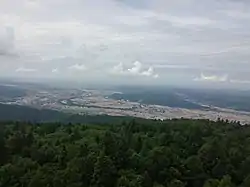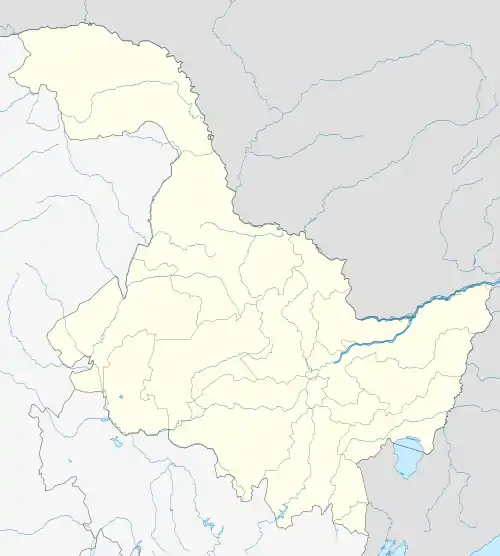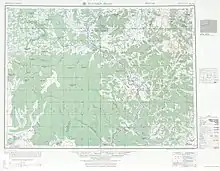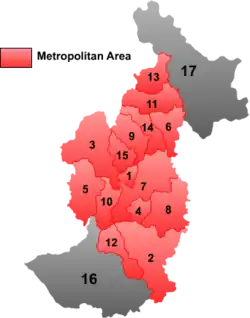Yichun, Heilongjiang
Yichun (Chinese: 伊春; pinyin: Yīchūn) is a prefecture-level city on the Songhua river in Heilongjiang province, People's Republic of China. The city is separated from Russia by the Amur River and has an international border of 246 kilometres (153 mi). At the 2010 census, Yichun has a total population of 1,148,126 while 729,202 people live in 15 districts separated by forests.[1] The greening rate of Yichun is up to 83%. The nickname of Yichun is Lindu (Chinese: 林都; pinyin: Líndū; lit. 'forest capital').
Yichun
伊春市 I-ch'un | |
|---|---|
 Overview of Yimei, Yichun | |
| Nickname: Forest capital (林都) | |
.png.webp) Location of Yichun City (yellow) in Heilongjiang (light grey) and China | |
 Yichun Location of the city centre in Heilongjiang | |
| Coordinates (Yichun municipal government): 47°43′41″N 128°50′28″E | |
| Country | People's Republic of China |
| Province | Heilongjiang |
| County-level divisions | 17 |
| Municipal seat | Yimei District |
| Government | |
| • Type | Prefecture-level city |
| • CPC Yichun Secretary | Wang Aiwen (王爱文) |
| • Mayor | Gao Huan (高环) |
| Area | |
| • Prefecture-level city | 39,017 km2 (15,065 sq mi) |
| Population (2010)[1] | |
| • Prefecture-level city | 1,148,126 |
| • Urban | 598,000 |
| • Metro | 729,202 |
| Time zone | UTC+8 (China standard time) |
| ZIP code | 153000 |
| Area code | 0458 |
| ISO 3166 code | CN-HL-07 |
| Licence plates | 黑F |
| Climate | Dwb |
| Website | yc |
| Yichun | |||||||||
|---|---|---|---|---|---|---|---|---|---|
 "Yichun", as written in Chinese calligraphy | |||||||||
| Chinese name | |||||||||
| Chinese | 伊春 | ||||||||
| Postal | Ichun | ||||||||
| |||||||||
| Manchu name | |||||||||
| Manchu script | ᡳᡧᡠᠨ | ||||||||
| Romanization | Išun | ||||||||
| Russian name | |||||||||
| Russian | Ичунь | ||||||||
History

Yichun was named after the Yichun River (伊春河), which is a small tributary of Tangwang River (汤旺河). The word Yichun means "nine" in Mongolian language. During the Shang Dynasty Yichun was populated by the Sushen (肃慎). Before the Tang Dynasty, the region was inhabited by several nomad tribes in the northeastern border area of China including Sushen and Donghu. During the Qing Dynasty, Yichun was under the administration of Qiqihar and Hulan's Deputy Lieutenant-General (Fudutong) before it became a minor town under Tangyuan County's jurisdiction in the 1890s.
The region's real development began after the establishment of Manchukuo after Japanese force seized Manchuria in 1932. In November 1941, a railway from Suihua to Jiamusi was built before its branch was extended to today's Yichun district from Nancha in July 1942. In 1945, Yichun was established as Yichunjie (Yichun Street) under Tangyuan County's control. As a major center of lumber industry, Yichun has grown at an astonishing rate since 1949. In 1952 Yichun County was established by the PRC Government. On 13 Feb 1958 Yichun was designated a Prefecture-level city. However, in order to set up a pilot of the combination of enterprise management and government, The CPC Central Committee and State Council approved to establish Yichun Special District (伊春特区) instead of Yichun City in 1964. In 1979 the City of Yichun was reinstated. Jiayin and Tieli were put into Yichun's jurisdiction.[2]
Geography
Yichun is located in the northeast part of Heilongjiang with a border length of 2,495 km (1,550 mi), part of which faces Russia across the Amur River. The Lesser Khingan Mountains cross the city. The total administrative area is 33,000 km2 (13,000 sq mi). The channels and valleys are densely covered with trees and grasslands. There are 702 rivers, all of which are in the Amur and Songhua River drainage basins; the total water pondage is 10.2 billion cubic metres (360 billion cubic feet). The Tangwanghe River is the main river.
Climate
Yichun has a monsoon-influenced, hemiboreal climate (Köppen Dwb), with long, bitterly cold, but very dry winters, and very warm, humid summers. With an annual mean temperature of 1.6 °C (34.9 °F), it is among the coldest Chinese cities, and diurnal temperature variation tends to be large, especially in winter and spring. The monthly 24-hour average temperature ranges from −21.3 °C (−6.3 °F) in January to 20.9 °C (69.6 °F). During the warmer months, rainfall is somewhat enhanced by the mountainous topography, allowing for a generous annual precipitation total of 627 millimetres (24.7 in). However, the monsoon still means that more than 60% of the annual precipitation falls from June to August alone.
.jpg.webp)
| Climate data for Yichun (1991–2020 normals, extremes 1971–2010) | |||||||||||||
|---|---|---|---|---|---|---|---|---|---|---|---|---|---|
| Month | Jan | Feb | Mar | Apr | May | Jun | Jul | Aug | Sep | Oct | Nov | Dec | Year |
| Record high °C (°F) | 1.0 (33.8) |
8.0 (46.4) |
18.7 (65.7) |
28.9 (84.0) |
33.0 (91.4) |
38.2 (100.8) |
36.3 (97.3) |
35.4 (95.7) |
30.8 (87.4) |
26.8 (80.2) |
14.1 (57.4) |
5.0 (41.0) |
38.2 (100.8) |
| Average high °C (°F) | −13.3 (8.1) |
−7.0 (19.4) |
1.3 (34.3) |
11.7 (53.1) |
19.8 (67.6) |
24.5 (76.1) |
27.1 (80.8) |
25.2 (77.4) |
19.7 (67.5) |
10.5 (50.9) |
−2.5 (27.5) |
−12.7 (9.1) |
8.7 (47.7) |
| Daily mean °C (°F) | −20.9 (−5.6) |
−15.5 (4.1) |
−5.7 (21.7) |
5.0 (41.0) |
12.5 (54.5) |
17.8 (64.0) |
21.1 (70.0) |
19.1 (66.4) |
12.4 (54.3) |
3.8 (38.8) |
−8.6 (16.5) |
−19.0 (−2.2) |
1.8 (35.3) |
| Average low °C (°F) | −27.5 (−17.5) |
−23.4 (−10.1) |
−13.0 (8.6) |
−1.7 (28.9) |
5.1 (41.2) |
11.6 (52.9) |
15.9 (60.6) |
14.2 (57.6) |
6.5 (43.7) |
−2.0 (28.4) |
−14.2 (6.4) |
−24.7 (−12.5) |
−4.4 (24.0) |
| Record low °C (°F) | −42.2 (−44.0) |
−41.2 (−42.2) |
−37.9 (−36.2) |
−18.6 (−1.5) |
−8.8 (16.2) |
0.5 (32.9) |
4.5 (40.1) |
0.4 (32.7) |
−6.9 (19.6) |
−22.5 (−8.5) |
−33.1 (−27.6) |
−40.4 (−40.7) |
−42.2 (−44.0) |
| Average precipitation mm (inches) | 6.1 (0.24) |
6.5 (0.26) |
14.4 (0.57) |
26.8 (1.06) |
56.5 (2.22) |
125.7 (4.95) |
161.8 (6.37) |
137.0 (5.39) |
72.1 (2.84) |
32.4 (1.28) |
14.5 (0.57) |
10.7 (0.42) |
664.5 (26.17) |
| Average precipitation days (≥ 0.1 mm) | 8.7 | 5.8 | 7.8 | 9.1 | 13.0 | 15.4 | 15.5 | 15.4 | 11.6 | 8.9 | 8.6 | 10.4 | 130.2 |
| Average snowy days | 12.4 | 9.2 | 10.6 | 5.4 | 0.2 | 0 | 0 | 0 | 0.1 | 4.5 | 10.9 | 13.9 | 67.2 |
| Average relative humidity (%) | 70 | 65 | 59 | 55 | 61 | 75 | 80 | 83 | 77 | 65 | 69 | 72 | 69 |
| Mean monthly sunshine hours | 154.9 | 192.0 | 234.8 | 221.2 | 240.2 | 223.3 | 218.2 | 203.5 | 198.7 | 178.2 | 149.5 | 130.0 | 2,344.5 |
| Percent possible sunshine | 56 | 66 | 63 | 54 | 51 | 47 | 46 | 47 | 53 | 54 | 54 | 50 | 53 |
| Source 1: China Meteorological Administration[3][4] | |||||||||||||
| Source 2: Weather China[5] | |||||||||||||
Subdivisions
On 13 Jun 2019, the District division adjustment plan of Yichun, which plans to merge all of the original 15 districts to 4 districts and 4 counties was approved by the State Council.[6]
Yichun, Heilongjiang currently comprises 4 districts, 1 county-level city and 5 counties.
Districts: Yimei, Wucui, Youhao and Jinlin
County-level city: Tieli
Counties: Tangwang, Fenglin, Nancha and Dajingshan
| Name | Hanzi | Hanyu Pinyin | Population (2010 census) | Area (km2) | Density (/km2) | Former division |
|---|---|---|---|---|---|---|
| Yimei District | 伊美区 | Yīměi Qū | 186,982 | 2,359 | 79.26 | Yichun, Meixi |
| Wucui District | 乌翠区 | Wūcuì Qū | 76,376 | 2,814 | 27.14 | Wumahe, Cuiluan |
| Youhao District | 友好区 | Yǒuhǎo Qū | 72,989 | 3,827 | 19.07 | Youhao, Shangganling |
| Jinlin District | 金林区 | Jīnlín Qū | 91,959 | 2,307 | 39.86 | Jinshantun, Xilin |
| Tangwang County | 汤旺县 | Tāngwàng Xiàn | 52,126 | 4,425 | 11.77 | Tangwanghe, Wuyiling |
| Fenglin County | 丰林县 | Fēnglín Xiàn | 98,894 | 5,263 | 18.79 | Wuying, Hongxing, Xinqing |
| Nancha County | 南岔县 | Nánchà Xiàn | 118,593 | 3,088 | 38.40 | downgraded into a county |
| Daqingshan County | 大箐山县 | Dàqìngshān Xiàn | 77,714 | 1,066.7 | 72.85 | Dailing, and parts of Tieli (Langxiang town) |
| Jiayin County | 嘉荫县 | Jiāyīn Xiàn | 68,579 | 7,273 | 9.42 | no changes |
| Tieli city | 铁力市 | Tiělì Shì | 303,914 | 6,593.3 | 46.09 | ceded Langxiang town to Dajingshan |
 | ||||||
| # | Name | Hanzi | Hanyu Pinyin | Population (2010 est.) | Area (km2) | Density (/km2) |
|---|---|---|---|---|---|---|
| 1 | Yichun District | 伊春区 | Yīchūn Qū | 146,074 | 100 | 1,461 |
| 2 | Nancha District | 南岔区 | Nánchà Qū | 118,060 | 3,088 | 38 |
| 3 | Youhao District | 友好区 | Yǒuhǎo Qū | 53,409 | 2,366 | 23 |
| 4 | Xilin District | 西林区 | Xīlín Qū | 51,938 | 457 | 114 |
| 5 | Cuiluan District | 翠峦区 | Cuìluán Qū | 44,976 | 1,560 | 29 |
| 6 | Xinqing District | 新青区 | Xīnqīng Qū | 43,054 | 1,181 | 36 |
| 7 | Meixi District | 美溪区 | Měixī Qū | 40,697 | 2,259 | 18 |
| 8 | Jinshantun District | 金山屯区 | Jīnshāntún Qū | 39,917 | 1,850 | 22 |
| 9 | Wuying District | 五营区 | Wǔyíng Qū | 33,980 | 1,040 | 33 |
| 10 | Wumahe District | 乌马河区 | Wūmǎhé Qū | 31,391 | 1,254 | 25 |
| 11 | Tangwanghe District | 汤旺河区 | Tāngwànghé Qū | 30,980 | 1,263 | 25 |
| 12 | Dailing District | 带岭区 | Dàilǐng Qū | 32,256 | 1,040 | 31 |
| 13 | Wuyiling District | 乌伊岭区 | Wūyīlǐng Qū | 21,145 | 3,162 | 7 |
| 14 | Hongxing District | 红星区 | Hóngxīng Qū | 21,838 | 3,042 | 7 |
| 15 | Shangganling District | 上甘岭区 | Shànggānlǐng Qū | 19,487 | 1,461 | 13 |
| 16 | Tieli City | 铁力市 | Tiělì Shì | 350,358 | 6,620 | 53 |
Economy
The city's GDP topped RMB 20.24 billion in 2010, featuring a growth of 15.7% over the previous year.[7] In 2010, value-added industrial output generated by enterprises with designated size or above rose 29.3% to RMB 7.12 billion.[8] In 2010, the foreign trade value of Yichun totaled US$302.23 million, up 36.3% year on year.[8]
Wood processing and metallurgy are the main industries in Yichun. In 2010, value-added industrial output from wood processing increased 34% to RMB 2.01 billion, while that from metallurgy rose 39.2% to RMB 2.2 billion, accounting for 33.6% of the industrial sector's total. These two industries accounted for 91% of Yichun's total value-added industrial output according to the statistics in 2009.[7]
Transportation
Yichun Lindu Airport, located in a forest approximately 9 kilometres (5.6 mi) from downtown Yichun,[9] is the city's airport. It started operations in August 2009, and is capable of serving 142,000 passengers a year.[10] Yichun Railway Station operates daily trains to Harbin, the capital of Heilongjiang Province. The Yichun-Hegang Highway and the Yichun-Harbin Highway(part of Hegang-Harbin Highway) connect the city with other cities in Heilongjiang Province.[8]
References
- 2010年伊春市第六次全国人口普查主要数据公报 [Sixth National Population Census of the People's Republic of China]. Yichun Municipal Government. Retrieved 6 May 2011.
- Yichun Almanac Compilation Committee (1995). 伊春市志 [History of Yichun]. Heilongjiang People's Press. ISBN 9787207029201.
- 中国气象数据网 – WeatherBk Data (in Simplified Chinese). China Meteorological Administration. Retrieved 5 July 2023.
- 中国气象数据网 (in Simplified Chinese). China Meteorological Administration. Retrieved 5 July 2023.
- 伊春 - 气象数据 -中国天气网 (in Chinese). Weather China. Retrieved 28 November 2022.
- 黑龙江伊春市调整获批:撤销15个市辖区 新设8县区. Sina News (in Chinese (China)). 13 July 2019. Retrieved 2 May 2020.
- 伊春市2010年国民经济和社会发展统计公报. tjcn.org (in Simplified Chinese). 31 March 2011.
- "Yichun ( Heilongjiang ) City Information". Hong Kong Trade Development Council. Retrieved 5 September 2011.
- "Heavy fog shrouds airport as crash rescue continues". China Daily. 25 August 2010. Retrieved 25 August 2010.
- "Introduction of Lindu airport in Yichun city". CCTV News. 25 August 2010. Retrieved 25 August 2010.
External links
- Yichun City (in Chinese)
.png.webp)